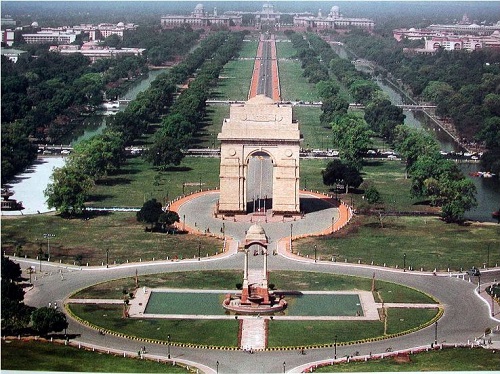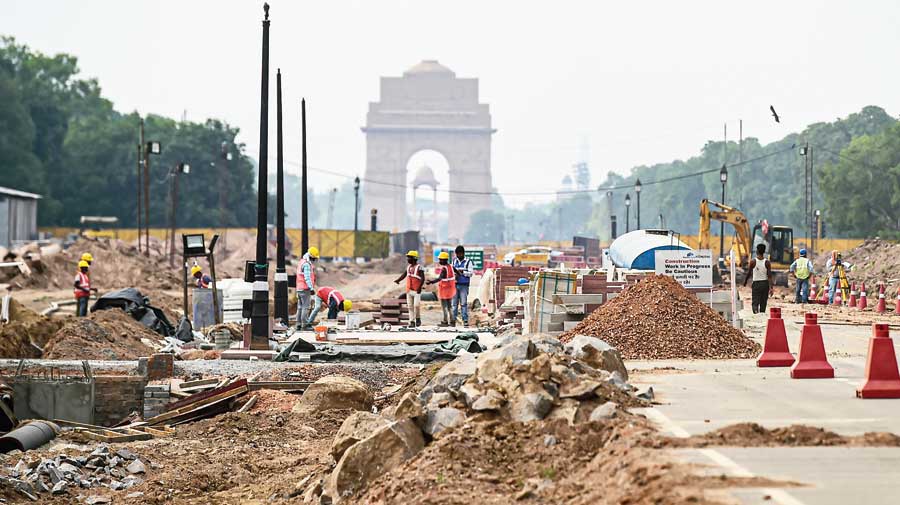We never called it Central Vista back then. To us kids it was always ‘India Gate.’ As in ‘Chalo, India Gate chalte hain.’ In fact, I came across this term ‘Central Vista’ only a little more than a year ago, when I read about the Central Vista Redevelopment Project which the Govt. of India is in a hurry to complete.
Having grown up in the 1960s and 70s within walking distance of India Gate and Rajpath, when my parents—both being Government servants—had secured sarkari accommodation on Pandara Road, not a week passed when I wouldn’t come visiting this breathtakingly beautiful part of New Delhi—arguably the most magnificent and impressive cityscape in the world, competing with the Champs-Élysées in Paris or the Washington Monument area in Washington DC, in my humble opinion.
For the benefit of non-Dilliwalas, the ceremonial boulevard called Rajpath runs from National Stadium to India Gate all the way to the monstrously wide Vijay Chowk, culminating in the Rashtrapati Bhavan on Raisina Hill. Let me give you an idea of what it looked like. Because, trust me, you will never see it like this again. Future generations will never know the magnificence of these surroundings.

India Gate and Rajpath above were an intrinsic part of my growing up. As kids, my dad would bring us here to go boating. This is where I learned to row a boat, though it was a flat bottomed one floating in a long, shallow channel. But being able to row confidently proved useful, especially when one embarked on a sea career later in life. There were ice creams to be had afterwards from the ice cream carts of Kwality and Caryhom milling about among the crowds. This was the place where my parents would drag me to, after waking me up early on cold, dark January mornings, to witness the spectacle of Republic Day almost every year, till I rebelled.
Summer holidays saw my neighbourhood friends and I take early morning walks on the lush green endless expanse of lawn to pick up jamun (blackberries) that would fall off the majestic row of trees marching into the distance. In the quieter moments, we’d inhale the silence and the fresh air. Suddenly the silence would be broken by birdsong, a live chorus that would startle us or make us smile.
I remember rushing to India Gate with my friend once in the midst of my exam preparation because a Bollywood film was being shot there. It was Roti, Kapda aur Makaan. Amid the huge, star-struck crowd collected, I did catch a glimpse of Manoj Kumar and Amitabh Bachchan. Never got to see the movie though, but I believe it was a dramatic scene.
We would organize cricket and football matches here….picnics too….and there were no guards or policemen to shoo us away. India Gate would give unfettered access to all and sundry—children, lovers, families, and office-goers. It was never the high-security zone it is likely to become soon.
As we grew older, we’d bring our air guns to try and shoot down some birds….yes, in those days of hunting birds we didn’t give it a second thought about what we were doing. Fortunately, I was a poor marksman and didn’t get a single one ever. But there was markedly more success in hunting birds of a different kind as I turned 19. Memories of a cold January night return, when a group of us, after an evening at the Wheels discotheque in Ambassador Hotel, walked the lawns of Rajpath to get sober, necking and nuzzling in the process, cold feminine hands snuggling into our jacket pockets to stay warm….
Memories, memories….
The vista used to be a picture-postcard scene—unforgettable—with huge lawns, canals, and rows of trees on both sides of the avenue. Yes, I do mention this in the past tense.
Because this is what it looks like presently.

The C.V.Project is currently underway. It aims to revamp a 3 km long Rajpath between Rashtrapati Bhavan and India Gate, convert the buildings North and South Blocks to museums, create a new common Central Secretariat to house all ministries, build a new Parliament building near the present one, plus new residences and offices for the Vice President and the Prime Minister at a total approximate cost of Rs. 18,000 crores.
The Govt of India’s stance in the face of protests is that India needs a new Parliament House to accommodate a larger Parliament in case its strength is increased in 2026. That the Indian Parliament and administrative buildings need a major face-lift. That it is paying exorbitant rent for existing office space in central Delhi. That government expenditure will create employment opportunities and help several industries. That inflation would be an issue if the project is delayed. That Rs. 35,000 crores has already been allocated as a one-time grant towards Covid-19 vaccination. That the project is an ‘essential service.’ Finally, that yeh sarkar bhaavnaon pe nahin chalti (or this govt. doesn’t run on feelings.)
Noted. But this blog is not about how the Govt feels. It is about how I do. And I have a few questions.
- Is this Project an ‘essential service’? Really? What is so essential about it? Can it not wait till we have the pandemic under control, say after the third wave, and not put thousands of labourers at risk?
- Should we not prioritize India’s messed-up vaccine programme instead? Whether it is the delayed approval for Covid-19 vaccines, the arbitrary pricing, the insensitive politics and the various flip flops by the govt? The only truth is that as of now just 3.3% of the Indian population is fully vaccinated. But that does not seem to be the priority here.
- The bill for free Covid-19 vaccines is said to be an additional Rs 15,000 cr over and above the budget allocation of Rs 35,000 cr. Can this extra amount not be taken from the Rs 18,000 cr allocated to the Central Vista Project? Can the palaces for the PM and the VP not wait? Because vaccination can’t!
- Can some efficient housekeeping and some imaginative up-gradation not suffice instead of new offices, Parliament and palaces? Think of the vast fortune that can be saved and put to better use! Like good public hospitals and oxygen plants all over the country?
- Do the PM and the VP really need new palaces? Why, are they living in dilapidated homes? Is the plumbing leaking? The White House is over 200 years old and even Donald Trump didn’t complain during his tenure.
- Since April this year, more than 12 million new cases have been detected and 120,000 people have died of Covid-19. Hospitals have run of beds, oxygen and other medical supplies. Crematoriums and graveyards in the country have been overflowing with bodies. Is it now a matter of prestige? Kucch bhi ho, kar ke dikhayenge? (Whatever it takes, it will be done.)
- Is history going to be rewritten for future generations by erasing India’s colonial past? Can the people’s history that resides in the 12 historic buildings to be torn down be shifted to new glossy structures? Are those buildings not a part of our national heritage?
- Are having all the government offices together a good idea? Is that not a security risk?
- According to the Govt., only two projects have been sanctioned so far—the new Parliament building and the development of the avenue—totaling about Rs. 1300 cr. But does anyone believe that the full sum of Rs.18,000 cr will eventually not be sanctioned by the Ministry of Urban Development and the Finance Ministry, knowing the coercive tactics that can and probably will be employed if the BJP does not get its way? The Delhi High Court has already dismissed a plea seeking direction to suspend all construction activity in view of the second wave of the pandemic, and even fined the petitioners.
So this ‘essential service’ continues at India Gate like a juggernaut. At any cost.
Meanwhile, I will nurse those precious memories of an era and a vista that will never return.
Beetashok Chatterjee is the author of ‘Driftwood’, a collection of stories about Life at Sea and ‘The People Tree’, another collection of stories about ordinary people with extraordinary experiences. A retired merchant ship’s captain by profession, he lives in New Delhi with his memories of living more than 40 years on the waves.
His book is available on Amazon. Click here.


Comments